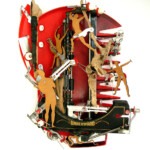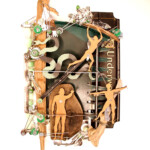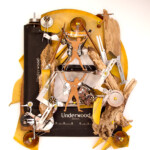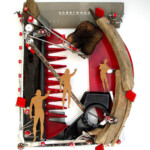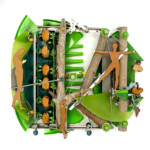The story of Adam’s expulsion from paradise for having consumed fruit from the tree of knowledge is but a few paragraphs in Genesis. In 1663 John Milton expanded that short story into a book-size epic poem, a wildly complex, extravagantly beautiful tale of the struggle between God and the fallen angel Satan over who would win the allegiance of the two human occupants of paradise. I was inspired by that ancient epic masterpiece of poetry in part just for its title: “Paradise Lost”. That one should live in a paradise and then suddenly lose it is inherently ironic and dramatic.
In 1808 William Blake drew 12 illustrations for a publication of “Paradise Lost”. All of the profiles in this series (the majority of which are from that 1808 series) are traced from Blake illustrations and cut by laser. Blake’s character’s gestures and stances, even as mere profiles, convey the universality of human folly, suffering, reverence and transcendence. I used these profiles as emoticons in my assembled sculptural version of paradise to convey my own twist on Milton’s epic poem.
The solemnity of my subject is lighted with humor, starting with the use of a variety of Underwood brand typewriter pieces and expressively complex weathered wood to represent the “tree of knowledge”. The “gate” of my paradise through which my Adam is expelled is represented by teeth of leaf rakes.
Starting from the left, the first three pieces show paradise corrupted by passion (intense red), wealth (jewel tones), and hubris (powerful yellow). In all three Adam is featured twice: first as an observer of this corruption and then as a reinvented self outside the gates of paradise after his expulsion. The fourth piece is red also as it represents the poignancy of the memories of all that was lost, as per the ascending hearts shown on the left of the charred structure of paradise. The sequences of numbers represent the years that Adam remembers from his time in paradise. The biggest memory of all is the memory of the expulsion itself, indicated by the enormous slightly charred chunk of wood with a bent rusty nail penetrating it.
The finale piece (positively green) has a dual story. As this Underwood is a “Golden Touch” brand from the 1950’s both stories are touched with gold. On the left Adam looks in reverence for all the good times he enjoyed back in paradise. On the right, for the fourth time in the series, I have used a Blake profile that seems in perfect balance and harmony with the world. Adam’s personal reinvention in the expansive world outside the gates of the lost paradise required of him a new balance and a new harmony with his environment. Genesis asserts that Adam lived 930 years after his expulsion with a considerable degree of success.
